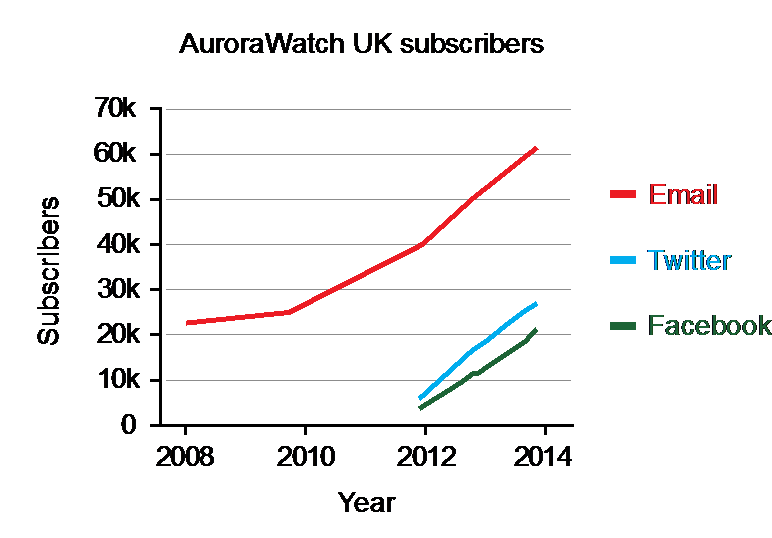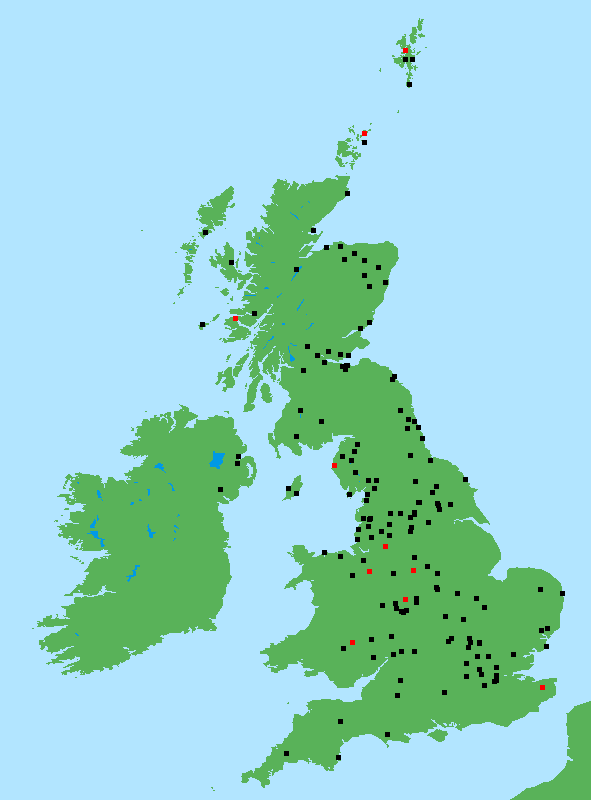Submitting Institution
Lancaster UniversityUnit of Assessment
PhysicsSummary Impact Type
TechnologicalResearch Subject Area(s)
Physical Sciences: Astronomical and Space Sciences, Atomic, Molecular, Nuclear, Particle and Plasma Physics
Earth Sciences: Geophysics
Summary of the impact
Lancaster undertakes fundamental research into the space plasma
environments. AuroraWatch UK, a spin-out of this research, provides a free
service alerting when aurorae may be visible from the UK. The number of
AuroraWatch subscribers has increased significantly from 22,000 in 2008 to
over 109,000 at present. A survey by the Royal Astronomical Society
suggests that AuroraWatch is very effective in promoting interest in
science. As a result of subscribing to AuroraWatch, 3667 respondents watch
science on television, 4437 read science magazines, websites and blogs,
524 now study science, 865 participate in citizen-science projects, and
1400 listed other changes in their behaviour (e.g. aurora sightseeing
trips). The AuroraWatch School programme involves 1800 pupils across UK.
Underpinning research
Research into understanding the coupling between the solar wind, the
magnetosphere and the ionosphere (the electrically charged upper portion
on the Earth's atmosphere) reveals insights into the plasma physics of the
space environment, in particular the temporal and spatial morphology of
particle precipitation into the upper atmosphere which produce aurora and
ionospheric currents.
The underpinning research is the dynamics and triggering of geomagnetic
storms/substorms which result in particle precipitation into the
atmosphere and the aurora. This is one of the main research areas
conducted at Lancaster and has been supported by PPARC/STFC and now by
NERC (RC1). Underpinning fundamental research into space plasmas, are a
family of ground-based experiments developed and are operated by Lancaster
space scientists which include ground-based magnetometers called SAMNET
(the UK Sub-Auroral Magnetometer Network).
Magnetic field variations measured by magnetometers are predominantly a
result of the coupling between the ionosphere, magnetosphere and solar
wind. In order to understand this global-scale system, it is necessary to
study magnetic field measurements spanning many hours of local time. In
practice, this means combining measurements from magnetometers located in
different locations, hence a need for operating a dense array of
magnetometers. Operation of SAMNET magnetometers was funded by PPARC/STFC
from 2003-2010 under UK solar-terrestrial physics (STP) national
facilities. Following the transfer of ground-based STP from STFC to NERC,
Lancaster has secured NERC funding.
One of SAMNET's scientific objectives is the detection of increased
geomagnetic activity. In essence, during such intervals the coupling
between the Earth's magnetic field and the interplanetary magnetic field
(which is embedded in the solar wind) is enhanced. This activity gives
rise to increased auroral activity in mid- and high-latitude regions.
During particularly active periods, the Aurora Borealis can be seen from
the UK. AuroraWatch UK (part of SAMNET's magnetometer network) is a free
public outreach service which alerts subscribers by e-mail or via social
media applications when the likelihood of aurorae appearing over UK is
high.
Outputs from our fundamental research also contribute to a greater
appreciation of the risk and hazards posed by space weather. The
publications listed below in section 3 utilised SAMNET data to describe
the triggering of substorms (Ref.1-3), and the particle precipitation
dynamics during geomagnetic storm (Ref. 4-5). The sixth publication
illustrates the geomagnetically induced currents in power transmission
lines after the substorm onset. All publications are in leading
peer-reviewed international journals.
References to the research
1. A. Keiling, M. Fujimoto, H. Hasegawa, F.
Honary, V. Sergeev, V. S. Semenov, H. U. Frey, O. Amm, H.
Rème, I. Dandouras, and E. Lucek. Association of Pi2 Pulsations and Pulsed
Reconnection: Ground and Cluster Observations in the Tail Lobe at 16 RE.
Annales Geophysicae — Atmospheres, Hydrospheres and Space Sciences. ISSN
0992-7689. 24 (12) pp. 3433-3449. doi:10.5194/angeo-24-3433-2006. 21st
December 2006. http://www.ann-geophys.net/24/3433/2006/angeo-24-3433-2006.html.
2. V.A. Sergeev, S. V. Apatenkov, V. Angelopoulos, J.P, McFadden, D.
Larson, J.W. Bonnell, M.Kuznetsova, N. Partamies, and F. Honary.
Simultaneous THEMIS observations in the near-tail portion of the inner and
outer plasma sheet flux tubes at substorm onset.; Journal of Geophysical
Research , Vol 113, A00C02, doi:10.1029/2008JA013527, 2008.
3. K. Takahashi, D. Berube, D. H.Lee, J. Goldstein, H.J. Singer, F.
Honary, and M.B. Moldwin. Possible evidence of virtual resonance in
the dayside magnetosphere, Journal of Geophysical Research, Vol. 114,
A05206, doi:10.1029/2008JA013898, 2009.
5. Z.C. Kale, I. R. Mann, C. L. Waters, M. Vellante, T. L. Zhang, and F. Honary.
Plasmaspheric Dynamics Resulting from the Hallowe'en 2003 Geomagnetic
Storms. Journal of Geophysical Research — Space Physics. ISSN 0148-0227.
114(A08204) pp. 1-12. doi:10.1029/2009JA014194. 11th August 2009.
Details of the impact
The aurorae captivate the public imagination and there is a great deal of
interest in this beautiful and mysterious natural phenomenon. The impact
of AuroraWatch was highlighted when Channel 4 contacted Farideh Honary
(SAMNET PI) in 2006 mentioning that the phrase "aurora borealis" was in
the top 100 of most searched-for terms in MSN's UK search engine, and
asked if they could visit Lancaster to produce a programme on aurorae.
Since then, SPEARS scientists have given more than 20 national/regional
radio interviews, have appeared on television to explain the auroral
phenomena, such as the BBC's Sky at Night ("The Merry Dancers", 2009,
~200,000 expected audience) and Horizon ("Solar storms — the threat to
Planet Earth", 2012, 1,800,000 expected audience), and have delivered 32
talks to schools and 60 presentations to public audiences (~500
attendees). In addition to TV and radio programmes, AuroraWatch has
featured in 10 newspaper/magazine articles since 2008 (RC2), and in the
book "Field notes from a hidden city: An urban nature diary" (Esther
Woolfson, 2013) (RC3). Lancaster's auroral research was the subject of a
short film ("Written in the sky: aurora borealis explained") produced by
the IOP in 2012 as part of the "Physics Lives" series, for A-level
students. It won a British Universities Film and Video Council award in
April 2013 and has over 16,960 viewings on YouTube (RC4).
The huge public interest is clear. AuroraWatch has over 109,000
subscribers, comprising 26,930 Twitter followers, 21,279 Facebook fans and
61,628 email subscribers. Users are encouraged to photograph the aurora
and share via our Flickr group, which has 771 members and 1,239 aurora
photographs since 2011. These numbers indicate a significant increase in
public engagement compared to 2008 when AuroraWatch had 22,000 subscribers
(RC5).
Professor Wild has delivered 12 enrichment lectures, to audiences of ~500
passengers, on board the Queen Victoria and Queen Mary cruise-liners
between 2008 and 2011. He has also delivered lectures to aurora
enthusiasts on four aurora pleasure flights (~130 passengers per trip).
The repeated invitations testify to the interest and impact of these
lectures (RC6).
The public support for AuroraWatch led to over 2500 individuals
expressing their concern to PPARC following its decision not to fund
SAMNET as a UK National Facility. At the time AuroraWatch had only 10,000
subscribers, hence the 2500 individual letters corresponds to 25% of
AuroraWatch subscribers. Their support letters constitute a four-volume
document which was sent to PPARC's Chief Executive. To view all these
letters, please see (RC7). Many AuroraWatch users are amateur astronomers
and radio amateurs. Following the public outcry over concerns that the
research council's decision might threaten the operation of SAMNET
magnetometers and the AuroraWatch service, Robert Goodwill, MP for
Scarborough and Whitby raised these concerns and questioned the Secretary
of State for Trade and Industry in Parliament over PPARC's decision
regarding SAMNET funding and the future of the AuroraWatch programme
(RC8). Following Mr Goodwill's intervention, Ben Wallace, MP for Lancaster
and Wyre, visited the SPEARS Group at Lancaster University in 2006 and
lobbied STFC (PPARC's successor) for the decision to be reconsidered. The
public support re-instated SAMNET's funding in 2007 (RC1).
According to a Royal Astronomical Society survey in October 2011,
AuroraWatch has had a significant impact on public's interest and
appreciation of science. The survey attracted 9971 responses (a response
rate of 25%, total number of AuroraWatch subscribers were <40000 in
2011) and found a range of positive impacts. For example, as result of
subscribing to AuroraWatch, 3667 respondents report that they watch more
science on television, 1348 read more science magazines, 3089 read more
science websites and blogs, 524 now study or plan to study science and 865
participate in citizen science projects. More than 1400 subscribers listed
other changes in behaviour including an interest in amateur astronomy,
buying a telescope or booking a cruise to the Arctic to see the aurora
(RC9).
The RAS survey indicated that school pupils were the age group
least-represented in the survey respondents. To increase participation by
school pupils we developed a wireless, low-cost magnetometer and obtained
funding from Lancaster University to construct ten magnetometers. A
competition was launched to select ten schools that would best incorporate
the magnetometer and its data into their teaching of STEM subjects. 164
applications from across the UK were received. The selected schools will
involve 1800 pupils in AuroraWatch related activities, including projects
for CREST awards, astronomy, science, physics, engineering, electronics
and STEM clubs, and comparison with solar telescope, sunspot, VLF
receiver, muon detector and high-altitude balloon radiation detector data
(RC10). The impressive response has encouraged Lancaster to seek further
funding to involve more schools in AuroraWatch.
Sources to corroborate the impact
RC1. The following research grants have supported the operation of
SAMNET magnetometer network since 2003:
F. Honary, The UK Sub-Auroral Magnetometer Network (SAMNET) rolling
grant, PPARC, ppa/g/2002/00482, 01/04/2003-31/03/2007, £284,069
F. Honary, SAMNET Operation, PPARC/STFC, 01/04/2007-31/03/2008,
PP/E001963/1, £46,742 F. Honary, Fundamental Plasma Processes, STFC,
ST/F003005/1, 01/04/2008-31/07/2010, £591,500
F. Honary, SAMNET data curation, STFC, ST/F008090/1,
01/12/2007-31/03/2008, £21,349.
J. Wild and F. Honary. A high-order model of the Earth's External and
Induced Magnetic Field, NERC, NE/J021792/1, 01/01/2013-31/12/2015,
£350,234.
RC2. For the list of media activities, including articles in
newspapers and magazines please see http://aurorawatch.lancs.ac.uk/news-coverage
RC3. Field notes from a hidden city: An urban nature diary. Esther
Woolfson. Published 7 March 2013 by Granta books,
http://grantabooks.com/Field-Notes-From-a-Hidden-City-2
AuroraWatch is featured on 3 occasions in this book (November 29th,
July 20th and July 23rd). Below is an excerpt from
November 29th which demonstrates the impact that AuroraWatch
has on the general public: "Every morning as I sit down at my desk, before
doing anything else — including work — I check a website that will inform
me if the aurora borealis, the Northern Lights, may be seen later in the
night skies above us. The site's called 'Aurora Watch', and is the website
of the UK Sub-Auroral Magnetometer Network, SAMNET, the body that, on
behalf of us all, keeps a usefully close eye on what's happening in the
arcane universe of space weather and on the aurora borealis, the only sign
visible from earth of the astonishing turbulences above us."
RC4. "Physics Lives" film, made on behalf of the Institute of
Physics, http://www.iop.org/education/higher_education/stem/showcasing/page_54368.html
The film won the British Universities Film and Video Council Learning on
Screen 2013 General Education Non Broadcast Award, http://bufvc.ac.uk/events/learningonscreen/winners
RC5. AuroraWatch UK website: http://aurorawatch.lancs.ac.uk/
Facebook page: https://www.facebook.com/aurorawatchuk
Twitter: https://twitter.com/aurorawatchuk
AuroraWatch UK Flickr group for subscribers photographs of aurora taken
from the UK:
http://www.flickr.com/groups/aurorawatch/

As a result of engaging with subscribers by social media the number of
AuroraWatch followers has increased from 22,000 to 109,000 in the last 5
years despite the low geomagnetic activities.
RC6. J. Wild. Astronomy at sea: Jim Wild's Cunard diary, Astronomy
and Geophysics, Vol. 50 no. 1.
RC7. Public support letters constituting a four-volume document
which was sent to PPARC's Chief Executive
RC8. House of Parliament: Questioning Secretary of State for Trade
and Industry in the house of Parliament over PPARC's decision regarding
SAMNET funding and the future of the AuroraWatch programme by Robert
Goodwill, MP for Scarborough and Whitby. 12 May 2006.
http://www.publications.parliament.uk/pa/cm200506/cmhansrd/vo060512/text/60512w0003.htm
RC9. Who watches aurora? Robert Massey, Astronomy and Geophysics
(A&G) Feb. 2012, Vol.53, issue 1.
RC10. AuroraWatch magnetometer for schools competition entries.
 Location of schools which entered the AuroraWatch schools magnetometer
competition. Selected schools are highlighted in red.
Location of schools which entered the AuroraWatch schools magnetometer
competition. Selected schools are highlighted in red.